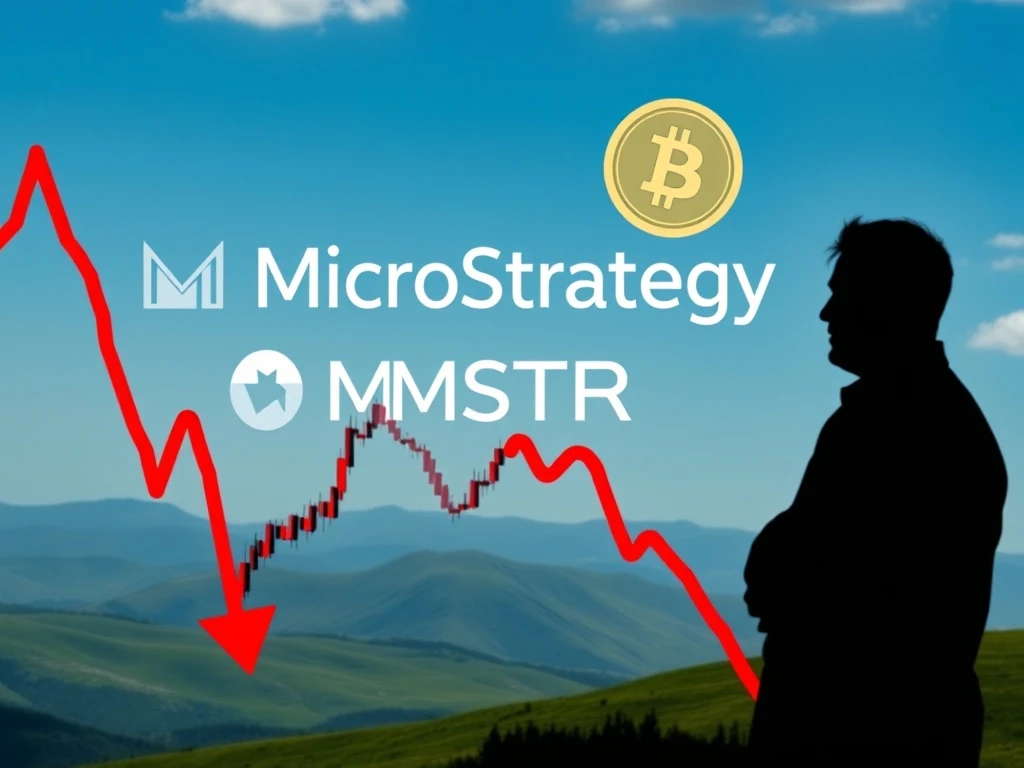MicroStrategy Faces Urgent Plunge as Saylor Shifts MSTR Strategy

MicroStrategy (MSTR) stock recently dropped to its lowest point in nearly four months. This significant decline follows a major announcement from Chairman Michael Saylor. The move signals a strategic shift in the company’s capital markets approach. Consequently, investors and the broader crypto community are closely watching these developments. This situation underscores the dynamic nature of the cryptocurrency investment landscape.
MicroStrategy Stock Plunges Amid Policy Shift
MicroStrategy’s stock price has fallen sharply. It is now at its lowest level since April. This decline aligns with a broader downturn for companies holding significant Bitcoin. The recent 8% drop in MSTR shares since Monday is notable. Furthermore, Bitcoin (BTC) itself saw an 8.6% decline after hitting a new all-time high last Thursday. This confluence of events highlights market sensitivities and increased volatility.
Chairman Michael Saylor recently updated MicroStrategy’s MSTR Equity ATM Guidance. He announced this change on Monday via an X post. This update offers the company greater flexibility. It impacts how MicroStrategy manages its capital market strategy. The guidance specifically addresses the issuance of new shares.
The revised guidance permits issuing MSTR shares under specific conditions. This can occur when MSTR trades below 2.5 times its net asset value (mNAV). Such issuances would cover debt interest. They could also fund preferred equity dividends. Additionally, shares might be issued when otherwise deemed advantageous to the company. This change represents a significant shift from previous policies. It grants MicroStrategy more operational leeway.
Michael Saylor’s Strategic Update Divides Community
This update has generated considerable debate among shareholders. Some argue it contradicts MicroStrategy’s Q2 earnings report. That report only mentioned issuing shares below 2.5x mNAV for debt or dividends. Conversely, other market observers view it positively. They believe it could allow MicroStrategy to acquire more Bitcoin. Crypto trader Kale Abe stated, “He’s literally telling you straight up he’s gonna buy a… ton more BTC.”
MicroStrategy currently holds 629,376 Bitcoin. This substantial stash is valued at approximately $71.34 billion. This makes it the largest corporate holder of the digital asset. The firm’s commitment to Bitcoin remains strong despite market fluctuations.
A former shareholder, Josh Man, expressed strong disappointment. He stated, “The head of the company said he wouldn’t sell below 2.5 mNAV, so I bought. He made this agreement with the shareholder at the live earnings release. And then he sold below mNAV 2.5.” This highlights the trust issue for some investors. Meanwhile, Bitcoin developer Endre Stolsvik offered a different perspective. He suggested the previous “no issue below mNAV 2.5” rule was too rigid. Stolsvik noted that MicroStrategy’s mNAV is now at 1.55, making the prior rule impractical.
MSTR Equity Guidance Sparks Controversy and Market Impact
Over the past month, MSTR has declined by 21.04%. It now trades at $336.57. The last time MSTR was at this level was April 17. At that time, the Bitcoin price traded around $84,030. This comparison shows a significant divergence between MSTR’s recent performance and Bitcoin’s higher valuation. The market appears to be reacting specifically to the new guidance.
This MSTR decline is not isolated. Several other public companies holding Bitcoin have also seen their stock prices fall. For example, MARA Holdings (MARA) is down 19.44%. Coinbase Global Inc (COIN) has dropped 26.97%. Riot Platforms (RIOT) also fell by 14.69%. This indicates a broader market trend affecting **crypto treasury firms**. The current market environment is challenging for these entities. Investors are reassessing their positions.
The debate surrounding Michael Saylor’s decision continues. It underscores the complexities of managing a public company with a significant Bitcoin treasury. The market will closely monitor MicroStrategy’s future moves. Its strategy impacts not only its own stock but also the perception of other Bitcoin-holding companies. The long-term implications of this new guidance remain to be seen. This ongoing situation provides valuable insights into corporate Bitcoin adoption strategies.









